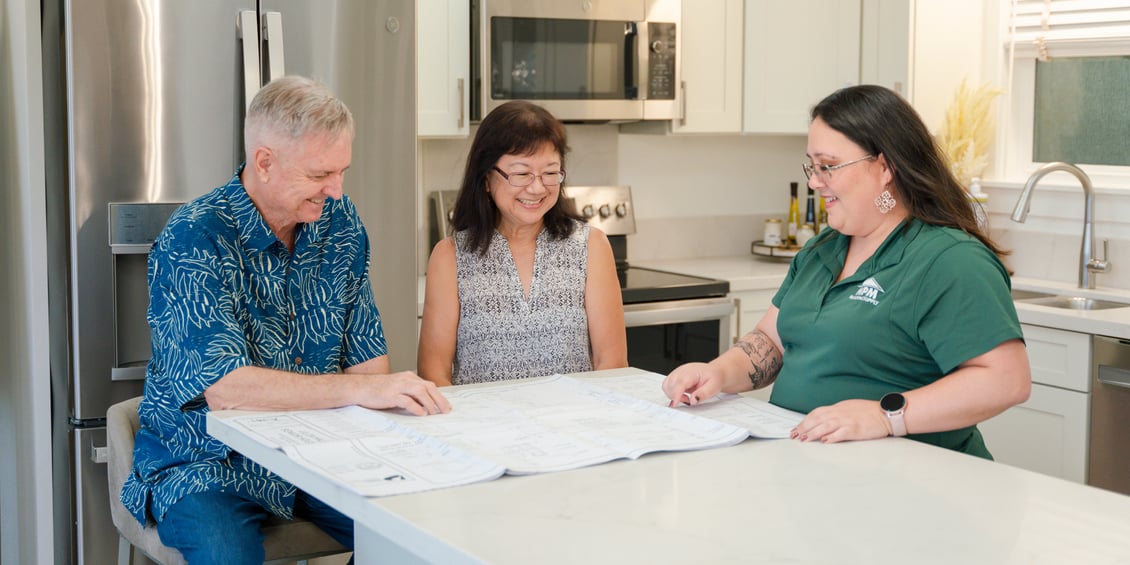Home Planning Guide Step 8: Secure Financing
Securing financing for your HPM Home is a crucial step in building your new home. Whether you’re a contractor or an owner-builder with a contractor,
On the HPM Blog, our goal is to be your guide through the entire home building process.
You’ll find remodeling tips, design inspiration, advice on working with pros, DIY projects and more!
Navigating your finances can be a challenging task, especially when it comes to homeownership. At HPM Building Supply, we understand that this is a significant investment and want to ensure that you are equipped to make confident decisions for your future. That’s why we asked HFS Federal Credit Union to share their expertise and advice to guide you in making the best choices for this investment in your new home.
Determining your budget is essential for us to provide you with the best possible options. If you plan on financing through a lender, we recommend obtaining pre-approval first to streamline the process. It's also worth asking your lender if they require bonding services, as we offer that as well.
Table of Contents
|
Tips for Figuring out Your Home-Buying Budget Understand the Financial Aspects |
| A Brief Introduction to Bonds |
| What's the Next Step in My 10-Step Journey? |
Ready to Move Forward? Request Information Now!

Tips for Figuring out Your Home-Buying Budget
1. Understand the Financial Aspects
![]() Building your new home is an exciting journey, and understanding the financial aspects is a crucial part of the process. Before you start, you'll need to secure a construction loan, which is a short-term loan used to finance the cost of building your home. Some lenders have a construction-to-permanent loan, which will automatically convert to a permanent mortgage loan (check with your lender regarding their different loan programs). Once your home is built, you can then refinance this construction loan into a conventional mortgage.
Building your new home is an exciting journey, and understanding the financial aspects is a crucial part of the process. Before you start, you'll need to secure a construction loan, which is a short-term loan used to finance the cost of building your home. Some lenders have a construction-to-permanent loan, which will automatically convert to a permanent mortgage loan (check with your lender regarding their different loan programs). Once your home is built, you can then refinance this construction loan into a conventional mortgage.
Now, let's talk about an important concept: the difference between what you qualify for and what you can afford. Just because a lender approves you for a certain amount doesn't necessarily mean you should borrow the full amount. It's essential to consider your lifestyle, future plans, and financial comfort zone when evaluating what your monthly payment will be.
2. Calculate Your Debt-to-Income Ratio
![]() To help you understand your financial standing, you can calculate your Debt-to-Income ratio (DTI). This ratio is a tool that lenders use to assess your ability to manage monthly payments and repay borrowed money. It's calculated by dividing your monthly debt payments by your gross monthly income.
To help you understand your financial standing, you can calculate your Debt-to-Income ratio (DTI). This ratio is a tool that lenders use to assess your ability to manage monthly payments and repay borrowed money. It's calculated by dividing your monthly debt payments by your gross monthly income.
For conventional mortgages, lenders typically prefer a DTI ratio of less than 40%. This means that no more than 40% of your gross monthly income should go towards paying debts, such as credit cards and student loans. If you're considering a Federal Housing Administration (FHA) loan, aim for a DTI ratio of less than 36%.
Remember, these are just guidelines. The lower your DTI, the more manageable your debts will be.
3. Make A List Of Expenses
![]() Before diving into the home-building process, create a list of all the costs associated with homeownership. This includes mortgage payments, property taxes, homeowner association dues, insurance premiums, and other fees that may be included in your loan.
Before diving into the home-building process, create a list of all the costs associated with homeownership. This includes mortgage payments, property taxes, homeowner association dues, insurance premiums, and other fees that may be included in your loan.
4. Consider The Long-Term Costs
![]() When planning to build or buy a home, it’s crucial to think beyond just the monthly payments. Consider possible future increases in property taxes, insurance premiums, and homeowner association fees to get a comprehensive understanding of your long-term expenses and how much flexibility that leaves you within your current budget. Don’t forget, you’ll also need to save up to cover unexpected future repairs and maintenance.
When planning to build or buy a home, it’s crucial to think beyond just the monthly payments. Consider possible future increases in property taxes, insurance premiums, and homeowner association fees to get a comprehensive understanding of your long-term expenses and how much flexibility that leaves you within your current budget. Don’t forget, you’ll also need to save up to cover unexpected future repairs and maintenance.
5. Select A Financing Option That Works For You
 Explore the various types of mortgage loans available to find one that aligns with your credit score and financial background. Shopping around and comparing rates will help you make an informed decision about the loan that best fits your budget and long-term goals.
Explore the various types of mortgage loans available to find one that aligns with your credit score and financial background. Shopping around and comparing rates will help you make an informed decision about the loan that best fits your budget and long-term goals.

Getting Pre-Approved
1. Check Your Credit Score
Before applying for a mortgage, review your credit score. This information is typically available through one of the three major credit bureaus - Experian, Equifax, or TransUnion (you're allowed to get a free report every 12 months from each credit bureau at annualcreditreport.com). Lenders will use this information to assess your eligibility for a loan and determine your interest rate.
2. Gather All Necessary Documents
Be prepared with essential documents such as tax returns, W-2s, bank statements, proof of income, and any other paperwork that verifies your financial situation before meeting with a lender.
3. Ask Questions
Research loan options so that you can determine which ones fit your budget and offer favorable terms in the long run. Don’t hesitate to ask your lender questions to fully understand the loan terms, monthly payments, and interest rates you can expect.
Initially, you'll need a construction loan, a unique type of financing designed specifically for new home construction. This loan operates on a progressive disbursement model, releasing funds as your home build advances.
Construction loans differ from traditional mortgages in several ways. They are short-term, typically higher in interest rates, and often require larger down payments. As you consider a construction loan, it's important to factor in the loan term, the cost of building materials, any potential additional costs during construction, and the estimated timeline for project completion.
Getting pre-approved and comparing different loan programs is a crucial step. It's also beneficial to work with an experienced contractor and loan officer who can provide valuable insights to guide your decisions. Once your home is complete, you'll transition from a construction loan into a conventional mortgage. This process, known as refinancing, allows you to convert the short-term construction loan into a long-term mortgage.
In-depth research, pre-approval, and collaboration with seasoned professionals is key when navigating construction loans. Understanding lender requirements and maintaining a healthy debt-to-income ratio can help streamline the loan application process, ensuring a smooth and successful home-building project.
What’s the Next Step in My 10-Step Journey?
In summary, it’s crucial to consider all these factors when deciding if a construction loan is the right fit for you. Conducting thorough research, obtaining pre-approval, and collaborating with an experienced contractor and loan officer will streamline the process and help you make the best financial decisions for your project. Knowing what constitutes a healthy debt-to-income ratio and understanding lenders' requirements will enable you to plan ahead and be fully prepared when applying for loans. Armed with this knowledge, you can confidently embark on your building project with HPM Building Supply, knowing that we’re here to simplify and support you every step of the way.
|
Ready to Begin Your Homeownership Journey? Contact our HPM Home Planning Consultants to schedule a consultation. Hilo: (808) 865-5820 | Waimea & Kona: (808) 865-5865 | Kaua‘i, O‘ahu & Maui: (808) 727-1039
|
 |
Securing financing for your HPM Home is a crucial step in building your new home. Whether you’re a contractor or an owner-builder with a contractor,
Navigating your finances can be a challenging task, especially when it comes to homeownership. At HPM Building Supply, we understand that this is a
Keep updated with the Latest News, Products, Deals and More!
© 2018 HPM BUILDING SUPPLY. ALL RIGHTS RESERVED
Receive the latest in HPM news, products, exclusive deals and more!
> Sign me up!©2023 HPM BUILDING SUPPLY | HOME PLANS, MATERIALS ALL RIGHTS RESERVED.

Copyright © 2022 HPM Building Supply. All Rights Reserved.